Page 187 of 258
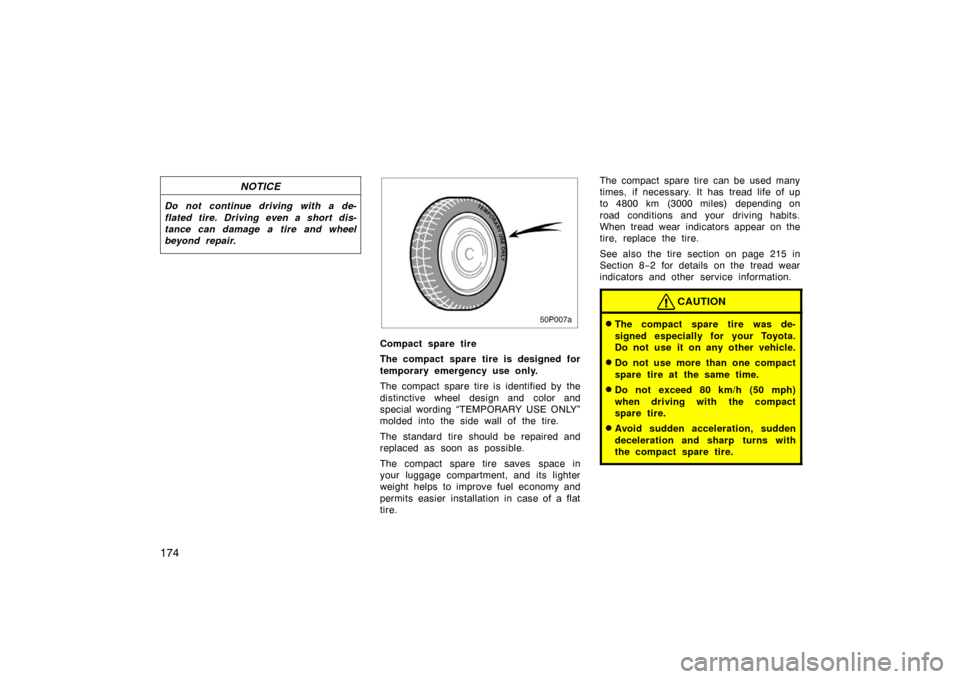
174
NOTICE
Do not continue driving with a de-
flated tire. Driving even a short dis-
tance can damage a tire and wheel
beyond repair.
50p007a
Compact spare tire
The compact spare tire is designed for
temporary emergency use only.
The compact spare tire is identified by the
distinctive wheel design and color and
special wording “TEMPORARY USE ONLY”
molded into the side wall of the tire.
The standard tire should be repaired and
replaced as soon as possible.
The compact spare tire saves space in
your luggage compartment, and its lighter
weight helps to improve fuel economy and
permits easier installation in case of a flat
tire.The compact spare tire can be used many
times, if necessary. It has tread life of up
to 4800 km (3000 miles) depending on
road conditions and your driving habits.
When tread wear indicators appear on the
tire, replace the tire.
See also the tire section on page 215 in
Section 8
−2 for details on the tread wear
indicators and other service information.
CAUTION
�The compact spare tire was de-
signed especially for your Toyota.
Do not use it on any other vehicle.
�Do not use more than one compact
spare tire at the same time.
�Do not exceed 80 km/h (50 mph)
when driving with the compact
spare tire.
�Avoid sudden acceleration, sudden
deceleration and sharp turns with
the compact spare tire.
Page 188 of 258
175
NOTICE
Your ground clearance is reduced
when the compact spare tire is
installed so avoid driving over ob-
stacles and drive slowly on rough,
unpaved roads and speed bumps.
Also, do not attempt to go through an
automatic car wash as the vehicle
may get caught, resulting in damage.
50p008a
1. Get the required tools and sparetire.
1 Wheel nut wrench
2 Jack handle
3 Towing eyelet (For emergency towing)
4Jack
5Spare tire
To prepare yourself for an emergency, you
should familiarize yourself with the use of
the jack, each of the tools and their stor-
age locations.
50p009
Turn the jack joint by hand.
To remove: Turn the joint in direction 1
until the jack is free.
To store: Turn the joint in direction 2 until
the jack is firmly secured to prevent it
flying forward during a collision or sudden
braking.
— R eq u ired to o ls an d sp are
tire
Page 189 of 258
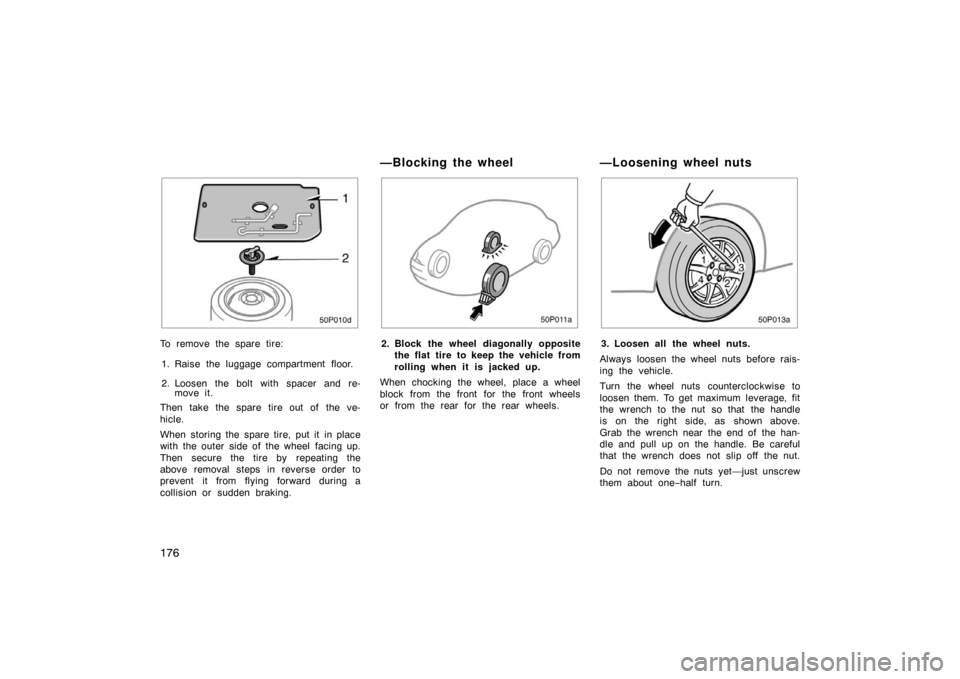
176
50p010d
To remove the spare tire:1. Raise the luggage compartment floor.
2. Loosen the bolt with spacer and re- move it.
Then take the spare tire out of the ve-
hicle.
When storing the spare tire, put it in place
with the outer side of the wheel facing up.
Then secure the tire by repeating the
above removal steps in reverse order to
prevent it from flying forward during a
collision or s udden braking.
50p011a
2. Block the wheel diagonally opposite
the flat tire to keep the vehicle from
rolling when it is j acked up.
When chocking the wheel, place a wheel
block from the front for the front wheels
or from the rear for the rear wheels.
50p013a
3. Loosen all the wheel nuts.
Always loosen the wheel nuts before rais-
ing the vehicle.
Turn the wheel nuts counterclockwise to
loosen them. To get maximum leverage, fit
the wrench to the nut so that the handle
is on the right side, as shown above.
Grab the wrench near the end of the han-
dle and pull up on the handle. Be careful
that the wrench does not slip off the nut.
Do not remove the nuts yet—just unscrew
them about one− half turn.
—Blocking the wheel —Loosening wheel nuts
Page 190 of 258
177
50p014c
4. Position the jack at the jack pointsas shown.
Make sure the jack is positioned on a
level and solid place.
50p015b
5. After making sure no one is in the vehicle, raise it high enough so that
the spare tire can be installed.
Remember you will need more ground
clearance when putting on the spare tire
than when removing the flat tire.
To raise the vehicle, insert the jack handle
into the jack (it is a loose fit) and turn it
clockwise. As the jack touches the vehicle
and begins to lift, double −check that it is
properly positioned.
CAUTION
Never get under the vehicle when the
vehicle is supported by the jack
alone.
—Positioning the jack —Raising your vehicle
Page 191 of 258
178
50p016
6. Remove the wheel nuts and changetires.
Lift the flat tire straight off and put it
aside.
Roll the spare wheel into position and
align the holes in the wheel with the bolts.
Then lift up the wheel and get at least the
top bolt started through its hole. Wiggle
the tire and press it back over the other
bolts.
50p017b
Before putting on wheels, remove any cor-
rosion on the mounting surfaces with a
wire brush or such. Installation of wheels
without good metal −to −metal contact at the
mounting surface can cause wheel nuts to
loosen and eventually cause a wheel to
come off while driving. Therefore after the
first 1600 km (1000 miles), check to see
that the wheel nuts are tight.
50p018b
7. Reinstall all the wheel nuts finger tight.
Reinstall the wheel nuts (tapered end in-
ward) and tighten them as much as you
can by hand. Press back on the tire and
see if you can tighten them more.
—Changing wheels —Reinstalling wheel nuts
Page 192 of 258
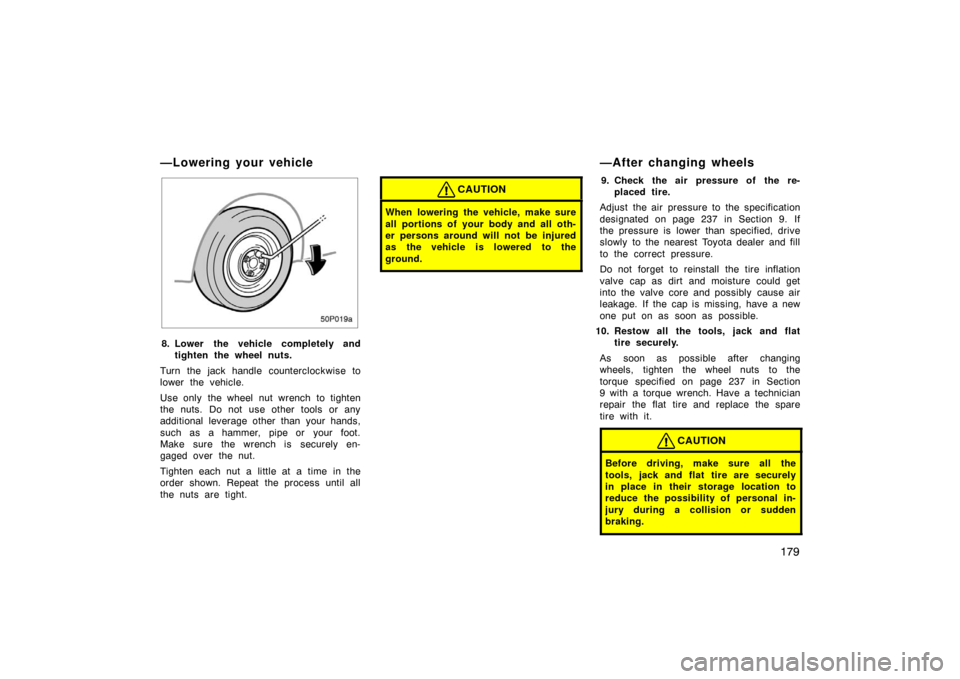
179
50p019a
8. Lower the vehicle completely andtighten the wheel nuts.
Turn the jack handle counterclockwise to
lower the vehicle.
Use only the wheel nut wrench to tighten
the nuts. Do not use other tools or any
additional leverage other than your hands,
such as a hammer, pipe or your foot.
Make sure the wrench is securely en-
gaged over the nut.
Tighten each nut a little at a time in the
order shown. Repeat the process until all
the nuts are tight.
CAUTION
When lowering the vehicle, make sure
all portions of your body and all oth-
er persons around will not be injured
as the vehicle is lowered to the
ground.
9. Check the air pressure of the re- placed tire.
Adjust the air pressure to the specification
designated on page 237 in Section 9. If
the pressure is lower than specified, drive
slowly to the nearest Toyota dealer and fill
to the correct pressure.
Do not forget to reinstall the tire inflation
valve cap as dirt and moisture could get
into the valve core and possibly cause air
leakage. If the cap is missing, have a new
one put on as soon as possible.
10. Restow all the tools, jack and flat tire securely.
As soon as possible after changing
wheels, tighten the wheel nuts to the
torque specified on page 237 in Section
9 with a torque wrench. Have a technician
repair the flat tire and replace the spare
tire with it.
CAUTION
Before driving, make sure all the
tools, jack and flat tire are securely
in place in their storage location to
reduce the possibility of personal in-
jury during a collision or s udden
braking.
—Lowering your vehicle —After changing wheels
Page 194 of 258
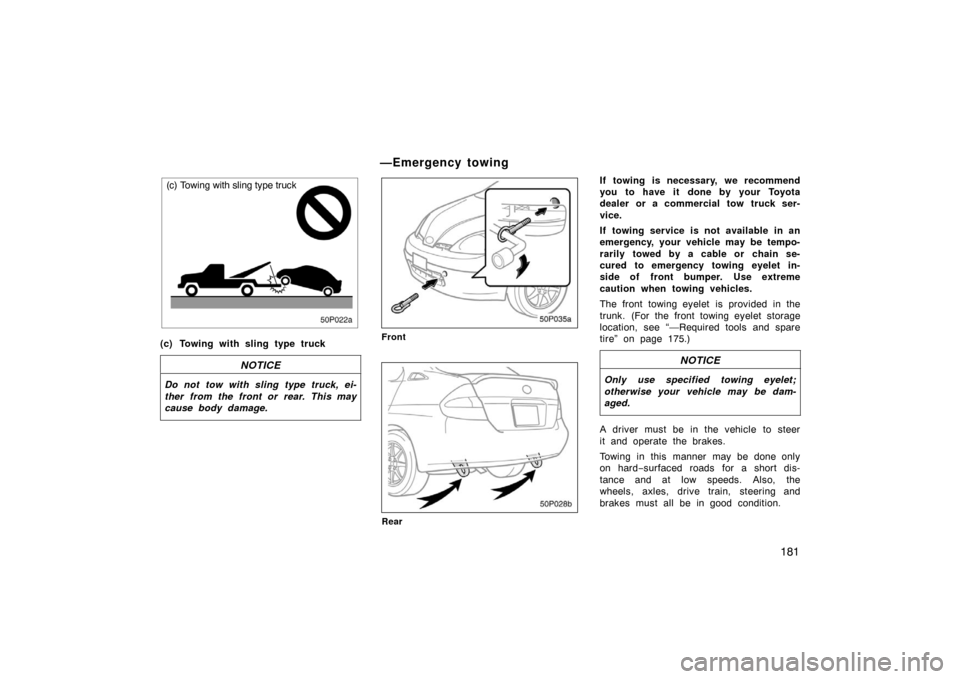
181
50p022a
(c) Towing with sling type truck
(c) Towing with sling type truck
NOTICE
Do not tow with sling type truck, ei-
ther from the front or rear. This may
cause body damage.
50p035a
Front
50p028b
Rear
If towing is necessary, we recommend
you to have it done by your Toyota
dealer or a commercial tow truck ser-
vice.
If towing service is not available in an
emergency, your vehicle may be tempo-
rarily towed by a cable or chain se-
cured to emergency towing eyelet in-
side of front bumper. Use extreme
caution when towing vehicles.
The front towing eyelet is provided in the
trunk. (For the front towing eyelet storage
location, see “—Required tools and spare
tire” on page 175.)
NOTICE
Only use specified towing eyelet;
otherwise your vehicle may be dam-
aged.
A driver must be in the vehicle to steer
it and operate the brakes.
Towing in this manner may be done only
on hard− surfaced roads for a short dis-
tance and at low speeds. Also, the
wheels, axles, drive train, steering and
brakes must all be in good condition.
—Emergency towing
Page 227 of 258
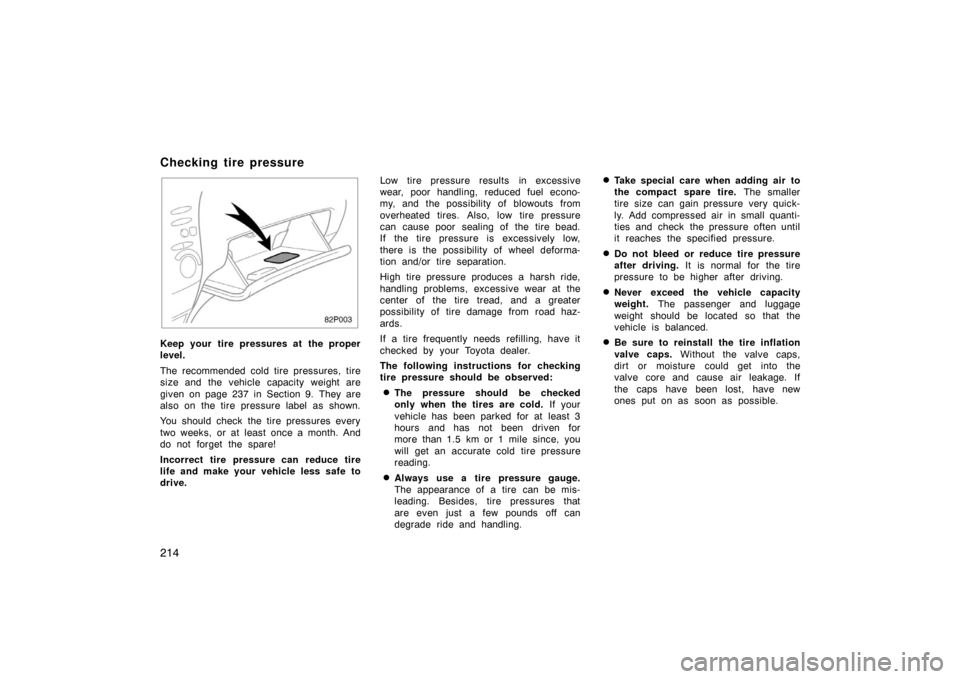
214
82p003
Keep your tire pressures at the proper
level.
The recommended cold tire pressures, tire
size and the vehicle capacity weight are
given on page 237 in Section 9. They are
also on the tire pressure label as shown.
You should check the tire pressures every
two weeks, or at least once a month. And
do not forget the spare!
Incorrect tire pressure can reduce tire
life and make your vehicle less safe to
drive.Low tire pressure results in excessive
wear, poor handling, reduced fuel econo-
my, and the possibility of blowouts from
overheated tires. Also, low tire pressure
can cause poor sealing of the tire bead.
If the tire pressure is excessively low,
there is the possibility of wheel deforma-
tion and/or tire separation.
High tire pressure produces a harsh ride,
handling problems, excessive wear at the
center of the tire tread, and a greater
possibility of tire damage from road haz-
ards.
If a tire frequently needs refilling, have it
checked by your Toyota dealer.
The following instructions for checking
tire pressure should be observed:
�The pressure should be checked
only when the tires are cold.
If your
vehicle has been parked for at least 3
hours and has not been driven for
more than 1.5 km or 1 mile since, you
will get an accurate cold tire pressure
reading.
�Always use a tire pressure gauge.
The appearance of a tire can be mis-
leading. Besides, tire pressures that
are even just a few pounds off can
degrade ride and handling.
�Take special care when adding air to
the compact spare tire. The smaller
tire size can gain pressure very quick-
ly. Add compressed air in small quanti-
ties and check the pressure often until
it reaches the specified pressure.
�Do not bleed or reduce tire pressure
after driving. It is normal for the tire
pressure to be higher after driving.
�Never exceed the vehicle capacity
weight. The passenger and luggage
weight should be located so that the
vehicle is balanced.
�Be sure to reinstall the tire inflation
valve caps. Without the valve caps,
dirt or moisture could get into the
valve core and cause air leakage. If
the caps have been lost, have new
ones put on as soon as possible.
Checking tire pressure